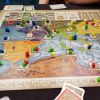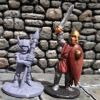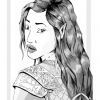-
Sep 19 '197 2hairylarry and RobboG like this
 Sep 19 '19hairylarryCarl's game, Wizards and Heroes, uses a d20 and 2 d6. (3 to roll stats) It turns out that 2d6 with advantage averages within a few hundredths of a d8 and 2d6 with disadvantage averages within a few hundredths of a d4. The spread is different but the average is the same. So you can approximate d4 and d8 with 2d6. And you can approximate percentile with d20*5. And if you need d10 just double the target and roll d20.
Sep 19 '19hairylarryCarl's game, Wizards and Heroes, uses a d20 and 2 d6. (3 to roll stats) It turns out that 2d6 with advantage averages within a few hundredths of a d8 and 2d6 with disadvantage averages within a few hundredths of a d4. The spread is different but the average is the same. So you can approximate d4 and d8 with 2d6. And you can approximate percentile with d20*5. And if you need d10 just double the target and roll d20. Sep 19 '19RobboGI like using a pool of d6. You start with 2d6. A bonus gives another die. So does a penalty. Bonuses and penalties cancel out. If you are left with no bonuses or penalties net -roll 2d6. If there are penalties roll that many extra dice and take the lowest two. If there are extra bonuses roll that many extra dice and take the two highest. It's less of a bump than just adding mods to 2d6.
Sep 19 '19RobboGI like using a pool of d6. You start with 2d6. A bonus gives another die. So does a penalty. Bonuses and penalties cancel out. If you are left with no bonuses or penalties net -roll 2d6. If there are penalties roll that many extra dice and take the lowest two. If there are extra bonuses roll that many extra dice and take the two highest. It's less of a bump than just adding mods to 2d6. Sep 19 '19hairylarry2d6 with slight advantage - roll 3 use 2 highest
Sep 19 '19hairylarry2d6 with slight advantage - roll 3 use 2 highest Sep 19 '19hairylarry2d6 with advantage - roll 4 use 2 highest
Sep 19 '19hairylarry2d6 with advantage - roll 4 use 2 highest Sep 19 '19hairylarry2d6 with big advantage - roll 5 use 2 highest
Sep 19 '19hairylarry2d6 with big advantage - roll 5 use 2 highest Sep 19 '19hairylarry...
Sep 19 '19hairylarry... Sep 19 '19RobboGYeah I figure rolling more than 5d6 is silly too. :DYou need to sign in to comment
Sep 19 '19RobboGYeah I figure rolling more than 5d6 is silly too. :DYou need to sign in to comment















